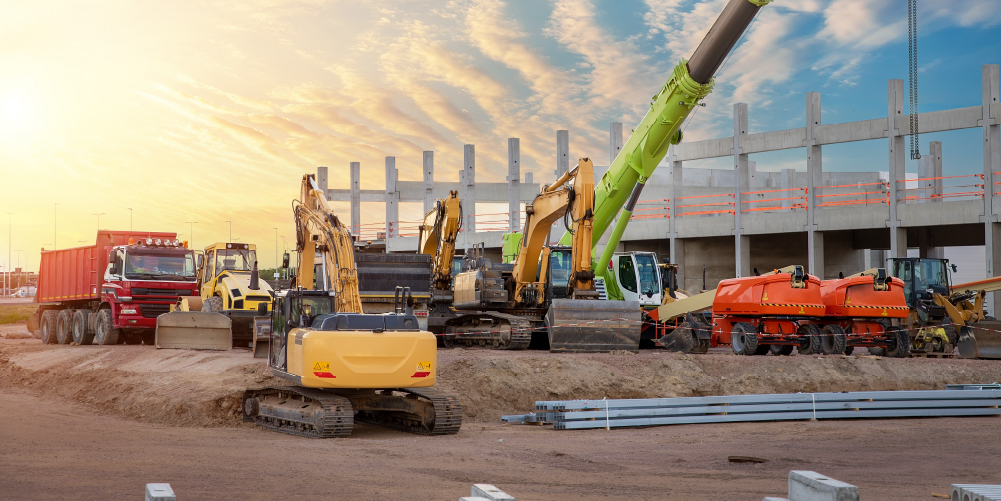— 11 min read
Heavy Civil Construction: Key Challenges & Best Practices
Last Updated Dec 5, 2024
Last Updated Dec 5, 2024

Heavy civil construction forms the basis of our functioning society. From large-scale public works projects to critical infrastructure, heavy civil construction projects are found in all aspects of modern life.
Some of the key aspects of heavy civil construction are massive jobsites, installation of complexly-engineered systems, use of Federal/Provincial/Municipal funds and increased stakeholder oversight in the design process.
Heavy civil construction overlaps significantly with infrastructure construction, a catch-all term for any kind of work that touches public infrastructure. Some contractors may even use these terms interchangeably. Roads, bridges, airports and water infrastructure facilities are all examples of projects that may be considered both heavy civil and infrastructure construction.
This article explores the challenges and unique aspects of heavy civil construction, including examples of projects, issues with scale and oversight and best practices for handling heavy civil jobs.
Table of contents
Unique Aspects of Heavy Civil Construction
In general, projects that are considered heavy civil instead of infrastructure tend to involve significant earth-moving and structural work, are complex and are highly engineered.
Because heavy civil work often requires work on transportation systems and infrastructure, the owners of these projects are typically public entities, and often these jobs operate as public-private partnerships (PPPs).
This can add complexity to completing these projects on time, as involvement from several governing bodies and municipalities can prolong the decision-making process in the design and preconstruction phases, and changes in political leadership can affect the approvals process.
Another unique aspect of heavy civil projects is the multifaceted roles that civil contractors can play. They often take on the responsibilities of a general contractor (GC), leading large projects on their own. But it's also not uncommon for these contractors to also serve as subcontractors, working under a GC and still handling a significant portion of labour on their own.
Sometimes civil contractors step into the role of project managers (PMs), particularly in the engineering, procurement, and construction (EPC) sector.
For any contractor working in heavy civil construction, it’s important to define the scope of each crew member’s job and keep in regular communication to make sure everyone stays on task.
Types of Heavy Civil Projects
The following lists a few examples of projects that a heavy civil contractor may take on.
Mining Operations
Building a mine is more than just blasting and drilling. It also requires constructing facilities and roads for extracted materials. A recent example is Canada’s Fort Hills project, which went into full production in 2018, and involved extensive excavation of one of the world's largest oil sands deposits. Another example includes the Voisey’s Bay Mine in Newfoundland and Labrador project which combines a mine and concentrator at its main site with dedicated port facilities in nearby Anaktalak Bay for efficient ore extraction and shipping.
Land Reclamation
Sometimes a body of water or wetland must be filled in to create new land for agriculture, infrastructure, or even residential areas. One massive and ambitious example of this is the Dubai Waterfront, which began in 2005 and aims to extend the city into the Arabian Gulf.
Flood Barriers
As climates change and cities grow, seaside areas have to construct new ways of preventing disaster. Completed in fall 2023, Calgary's Downtown Flood Barrier is a 1.39 km-long structure incorporating steel sheet piles, earthen berms, concrete walls, and removable stop log openings, designed to protect against a 1:200-year flood event.
Dam Construction
Erecting a dam involves large-scale excavation, foundation establishment, and concrete works to create a structure capable of controlling water flow. It can also serve to generate electricity for the surrounding area like The Grand Ethiopian Renaissance Dam is doing even before its full completion as Africa’s largest dam, as it harnesses the power of the Blue Nile River.
Tunnel Boring
Digging a tunnel requires complicated geological surveying, drilling, and specialized, expensive equipment to carve passageways through the earth, often to improve transportation systems like subways. The Gotthard Base Tunnel in Switzerland is one example, opening in 2016 after 17 years of construction to become the world's longest and deepest railway tunnel.
Port Construction and Expansion
Building a port can massively shift an area’s economics, but it also changes the land immensely, calling for extensive dredging, and building quays to hold large vessels. The Contrecœur Terminal expansion project aims to increase the Port of Montreal's container handling capacity by constructing a new terminal in Contrecœur. This development will add 1.15 million TEUs annually, supporting economic growth in Quebec and Eastern Canada while incorporating environmental considerations.
Common Challenges of Heavy Civil Construction
Some of the problems with heavy civil projects resonate across all kinds of construction: issues in terms of hiring a capable workforce, material delivery and procurement, inspection, permitting and coordination with Authorities Having Jurisdictions (AHJs), for example.
However, given the titanic scale of heavy civil projects, there are a handful of extra challenges a general contractor (GC) working in this field should look out for.
Stakeholder Oversight
Heavy civil projects often involve a substantial amount of government regulation and oversight, reflecting their large scale and the fact they are often funded with public money. There’s usually heightened emphasis on making sure every aspect of the project adheres to strict, government-regulated standards. This can end up being one of the most daunting challenges of heavy civil construction: extensive stakeholder involvement, which adds layers of complexity to project management.
Public entities funding the project often employ their own trade specialists, project managers and engineers who need to approve design plans and any change orders. Working with essentially double the typical number of design team members can slow the timeline of a project early on, making it a difficult process to get to the actual build.
Scale
Some civil work — such as building roads or even an airport — occurs across such vast stretches of land that it crosses municipalities or even provincial/territorial lines. This can make it difficult to effectively monitor every crew in the field.
Coordination across multiple building departments and government bodies is often necessary. Some projects, like pipeline installations, may span miles and need to consider environmental regulations in each jurisdiction they cross into.
The size of this work also impacts the amount of budget that will need to be allocated for equipment, and equipment costs tend to be higher than most commercial jobs. Over the course of the project, large, and costly amounts of equipment need to be rented or purchased, stored, maintained, rented — and, crucially, tracked across a huge worksite.
Data Collection
Given the massive scale and intense oversight of heavy civil work, it’s critical to obtain reliable data from the field. However, teams on the ground can be hesitant to adopt new technology, and crewmembers may not understand that their daily tasks are also important data points for higher-ups to manage.
It’s necessary to onboard workers to data collection software, with training that ensures they understand more than just how to use a software or system. Crewmembers must comprehend the value of entering good data that will be useful to their management teams.
Changing the culture of a workforce means taking the time to explain how the data someone enters will affect the project as a whole, and how someone’s daily log may be turned into actionable information for a PM or GC, and could even make its way into a report to stakeholders.
Site Preparation
An aspect of heavy civil work that really sets it apart from commercial construction is site preparation. The entire preconstruction phase can be both expensive and extensive, sometimes stretching over months or even years, as developers conduct feasibility studies and obtain approvals from every relevant governing body before actual construction can begin. At this point, the project might run into issues of zoning, and its team may have to attempt rezoning, a process that can take several more years and soak up millions of dollars.
These problems can intensify when dealing with government entities, as changes in administration can unravel prior agreements and force developers to revisit the entire permitting process.
Best Practices for Working in Heavy Civil Construction
Heavy civil construction can be a complex field, but using a few key strategies can help smooth the process of completing the job on time.
In particular, effective communication, fostering teamwork to address problems, and taking advantage of technology to streamline organization can be incredibly useful.
Communication
It’s incredibly common on any construction site that work doesn’t get done—or done correctly—because workers onsite didn’t speak to each other. These incidents can add up, and a project can quickly descend into chaos without a well-orchestrated communication strategy.
Relevant information channels between GCs, subcontractors, design teams, and stakeholders are essential, especially given the added complexity of giving stakeholders so much oversight in heavy civil projects. Establishing robust communication from the start—and having regular, coordinated meetings with all parties to share news and keep workers engaged in their project—can help foster an environment where information flows efficiently, preventing costly misunderstandings and delays.
Regular owner-architect-contractor (OAC) meetings ensure alignment between the ownership, developers, and builders, while internal team briefings keep day-to-day operations on track.
However, effective communication also extends beyond the interactions between project teams; it includes engaging with the wider community affected by the project. Public relations can become an integral part of the communication strategy, and management teams should host community meetings to discuss the progress, phases, and impacts of the project.
These efforts help manage expectations, keep residents informed, and address their concerns while anticipating any issues they may have.
Collaboration
Fostering collaboration on a heavy civil construction site starts with identifying and engaging all stakeholders early, creating a foundation of communication that maintains everyone's involvement from start to finish. To maintain this collaborative spirit, regular and structured meetings are key, ensuring that all parties—from general contractors to government officials—are aligned on goals, timelines, and responsibilities.
Even though these jobs often have more sign-offs from stakeholders and governmental agencies that can slow the process down, this level of oversight can also have benefits. When challenges come up, a larger pool of experts and stakeholders can gather to brainstorm solutions.
Since government bodies hold power over the land being developed, they can also be useful in gaining approvals and acquiring permits that might otherwise take a long time.
Plus, since construction is an industry of people and connections, increased access to governmental agencies and workers is a benefit that can be reaped in the long run, as a GC may need these contacts in future jobs to gain approvals on time.
Finally, given that these projects can experience hurdles at the government level, it can be helpful to tune into the local political landscape, and form relationships within it, so that the project has less risk of being waylaid by turnover.
Connection
In the context of heavy civil construction, the need to connect goes beyond physical interactions; massive workforces and fast-paced work across long expanses of land mean that using software to keep logs and documentation of the workplace is critical.
Using construction management software to its maximum potential can help streamline communications across a huge workforce. Being able to track changes to plans and drawings in real time, and the ability to share this data with the many eyes on the design team who need to approve it, can help speed up the decision-making process and keep a project on track.
During the build, given how large these worksites can be, it’s especially important to keep meticulous documentation of safety issues and inspection reports. Having access to real-time data and the exact location of an incident or inspection can reduce time spent tracking these places down, and can help a GC or PM keep focus on quality control or enhancing safety measures to minimize the risk of future accidents.
Documentation, however, is only useful if it’s accurate, and many construction workers are hesitant to add more technological processes to their workdays. To overcome the challenge of training an old-school workforce to embrace technology, it might be useful to involve crews and foremen in the transition process, potentially through incentive programmes that reward efficient and consistent data entry.
Mastering the Complexity of Heavy Civil Construction
Contractors tend to stick to either heavy civil or commercial construction, but it is possible to move across this divide. The heavy civil field, while challenging, offers great opportunities for GCs looking to expand their horizons.
In general, the vast scope of projects within heavy civil means that contractors tackle some of the most impactful work in the world, with the projects they work on literally shaping society upon completion.
Embracing the challenges of heavy civil construction can not only bolster one's expertise across all of construction but also open the door to potentially lucrative and high-profile projects.
Categories:
Tags:
Written by
Jacob Kunken
21 articles
Jake Kunken currently works as Solutions Engineer for Procore's Heavy Civil division. He brings 14 years of experience working in various construction roles in New York and Colorado, including laborer, assistant carpenter, carpenter, assistant superintendent, superintendent, construction manager, safety manager, and project manager. Jake also spent time in EHS as an environmental engineer for Skanska. He’s worked on more than 40 commercial projects from ground-up, to heavy civil, hospital work, and tenant improvement. Jake studied Ecological Technology Design at the University of Maryland.
View profileTrey Strange
26 articles
Trey Strange is a Peabody and Emmy-Award winning writer and producer based in Brooklyn, NY. Throughout his career, Trey has worked for the Huffington Post, Houston Chronicle, Out Magazine, Brooklyn Eagle, CNBC, INTO, and New York Magazine's Bedford + Bowery. He received his Masters in Journalism and Middle East studies from New York University, and Bachelors in the same subjects from the University of Houston.
View profileReviewed by
Khaled Kalawi
Khaled Kalawi is a Principal Strategic Product Consultant at Procore. With extensive experience in construction and engineering, Khaled has held key project management roles at organizations such as Southland Holdings and STRABAG. During his tenure at STRABAG, he held multiple positions including Lead Estimator, Tunnel & Site Engineer, and Tunnel Engineer, demonstrating his expertise in project estimation, tunneling, and site management. He has successfully overseen multimillion-dollar projects, optimized excavation procedures, and implemented innovative solutions that increased efficiency and reduced costs. His early career includes a role as Site Inspector at Khatib & Alami CEC, where he ensured compliance and quality for high-rise residential projects in Beirut. Khaled holds both a bachelor's and master's degree in Civil Engineering from Queen's University. He lives in Toronto.
View profileExplore more helpful resources

Equipped for Success: The Risks and Rewards of Construction Equipment
Even before written language, humans used tools to build. Contractors couldn’t have built the amazing feats seen and used in everyday life without machinery. From handheld tools to multi-storey tower...

The Percentage of Completion Method Explained
Accounting for income and expenses can present a real challenge for contractors, especially on long-term projects. The percentage of completion method is one of the most common methods of accounting...

What Is a General Contractor?
In the construction industry, a general contractor is the person or company responsible for overseeing a construction project. Property owners will typically hire general contractors to ensure a construction job...

MasterFormat: The Definitive Guide to CSI Divisions in Construction
Often referred to as the “Dewey Decimal System” of construction, the Construction Specifications Institute (CSI) MasterFormat is the industry standard in North America for organizing construction specifications. This system enables...